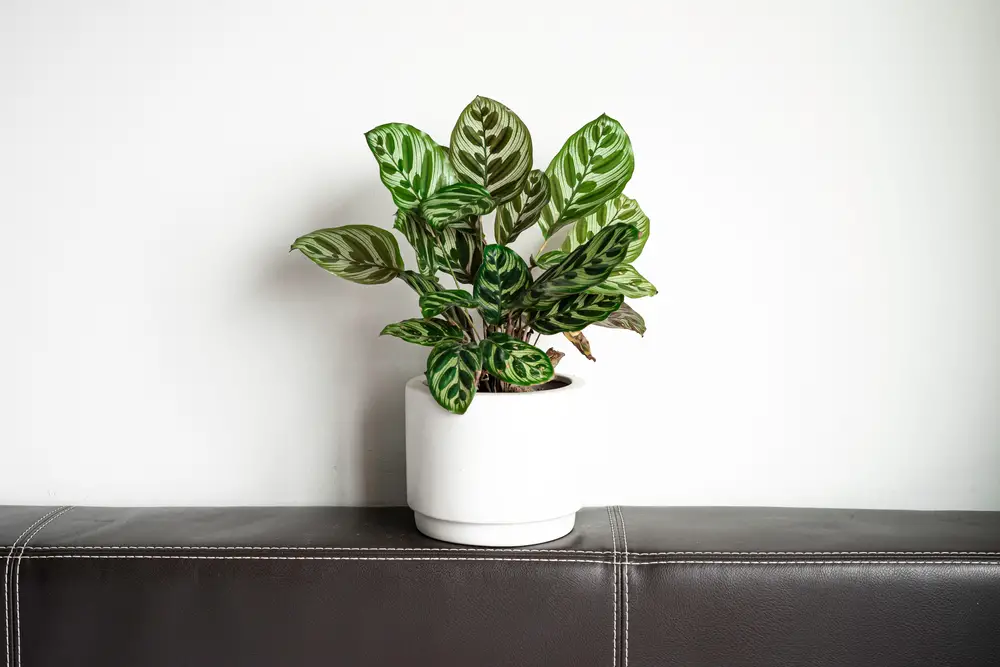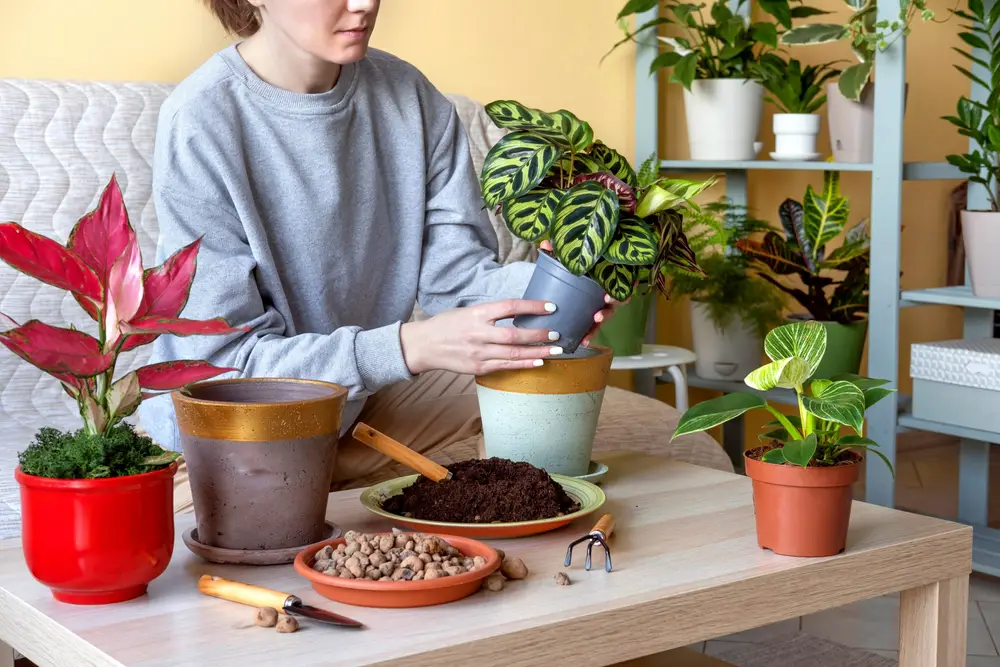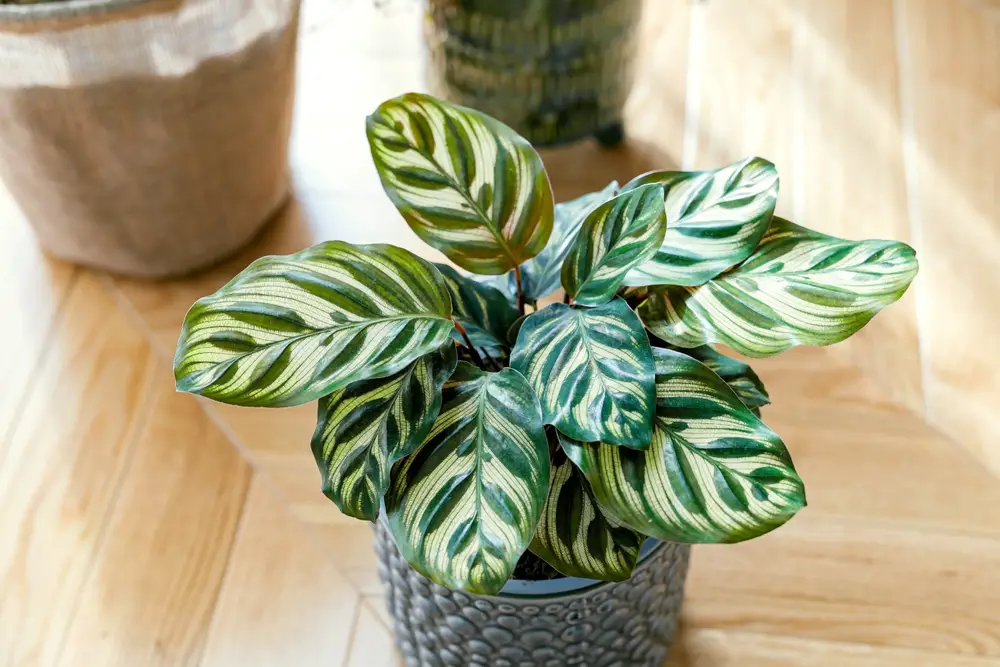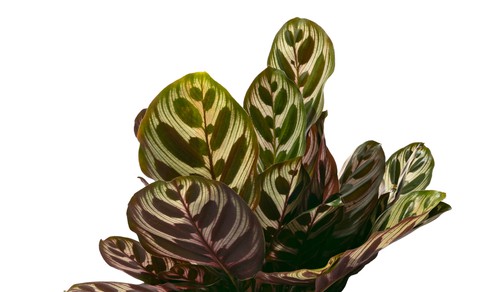Peacock plants, also known as Calathea makoyana, are a popular indoor plant with striking foliage that features green and silver stripes with purple undersides.
While they are relatively easy to care for, peacock plant owners may encounter the issue of leaves turning yellow. This can be a cause for concern, as yellowing leaves can be a sign of a larger problem.
There are several reasons why peacock plant leaves may turn yellow. Overwatering is a common cause, as it can lead to root rot and other issues. Nutrient deficiencies can also cause yellowing leaves, as can pests and diseases.
Understanding the potential causes of yellowing leaves is the first step in troubleshooting the problem and restoring the plant to health.
Key Takeaways on Peacock Plant Leaves Turning Yellow
- Peacock plants are a popular indoor plant with striking foliage that can turn yellow for a variety of reasons.
- Understanding the ideal growing conditions for peacock plants, including proper watering and fertilization, can help prevent yellowing leaves.
- Troubleshooting common problems, such as pests and diseases, can also help keep peacock plants healthy and vibrant.
See these other top picks in this category:
- Peach Tree Leaves Turning Yellow with Brown Spots
- Passion Fruit Leaves Turning Yellow
- Papaya Leaves Turning Yellow
Understanding Peacock Plant

Peacock Plant Basic Description
Peacock Plant (Calathea makoyana) is a tropical plant that belongs to the Calathea genus. It is native to Brazil and South America and is an evergreen perennial.
The plant is known for its striking foliage, which features green leaves with a feather-like pattern in shades of silver and pink. The undersides of the leaves are a deep purple color, which adds to the plant’s aesthetic appeal.
Origin and Habitat
Peacock Plant is native to the tropical rainforests of Brazil and South America. It thrives in warm, humid environments and prefers filtered sunlight or partial shade. The plant is commonly grown as a houseplant in other parts of the world, where it is appreciated for its ornamental value.
Varieties of Peacock Plant
There are several varieties of Peacock Plant, each with its own unique characteristics. Some of the most popular varieties include:
- Calathea makoyana ‘Medallion’: This variety features larger leaves with a more pronounced feather-like pattern.
- Calathea makoyana ‘Peacock’: This variety has a more vibrant coloration, with brighter shades of pink and silver.
- Calathea makoyana ‘Roseo-Picta’: This variety has a more compact growth habit and features leaves with a pinkish tinge.
Ideal Growing Conditions for Peacock Plant

Peacock plants, also known as Calathea Makoyana, are native to the tropical forests of Brazil. These plants are known for their beautiful foliage, which features green and silver leaves with purple undersides.
However, yellowing leaves can be a common issue for peacock plant owners. To prevent yellowing, it is essential to provide the plant with the ideal growing conditions.
1. Light Requirements
Peacock plants prefer bright, indirect light. Direct sunlight can cause the colors and patterns on the leaves to fade. Filtered light conditions are recommended, but these plants can also grow in full shade, although this can slow down growth significantly.
2. Watering Needs
Peacock plants prefer to be kept moist but not overly wet. It is essential to maintain moist soil, and watering should be done once the surface of the soil starts to dry. Rainwater or filtered water is ideal for watering peacock plants as they are sensitive to chemicals found in tap water.
3. Temperature Preferences
Peacock plants prefer warm temperatures ranging from 60-75°F (16-24°C) for best growth. These plants are sensitive to drafts, so it is essential to keep them away from doors and windows. Room temperature is ideal for peacock plants.
4. Humidity Levels
Peacock plants prefer high humidity levels, and they thrive in humid environments. It is essential to keep the plant in a room with a humidifier or place a tray of water near the plant to increase humidity levels.
5. Soil Preferences
Peacock plants prefer well-draining general-purpose houseplant potting mix. A peat-based commercial potting mix or African violet soil mix is ideal for the peacock plant. This plant wants soil with coarse mulch, leaves (or other organic matter), peat moss, and sand or perlite in a perfect state.
6. Potting and Drainage
Peacock plants prefer to be slightly root-bound, so it is essential to choose a pot that is slightly smaller than the root ball. The pot should have drainage holes to prevent waterlogging, which can cause the roots to rot.
To provide plants with proper drainage, soil can be combined with something that holds onto moisture and creates air pockets in the soil. Coconut coir and peat moss are good at retaining moisture, while gravel, pebbles, sand, or chopped up will work to improve airflow.
Peacock Plant Care

Peacock plants are a beautiful addition to any indoor garden, but yellowing leaves can be a sign of problems. Proper care is essential to keep these plants healthy and thriving. Here are some tips for peacock plant care:
1. Feeding and Fertilizing
Peacock plants benefit from regular feeding and fertilizing. Using a balanced fertilizer with essential nutrients like nitrogen can help keep the leaves green and vibrant.
It is recommended to fertilize the plant every two weeks during the growing season, which is from spring to fall. Be careful not to over-fertilize, as this can cause damage to the roots.
2. Watering and Moisture Control
Peacock plants prefer moist soil, but overwatering can lead to root rot and yellowing leaves. It is recommended to water the plant when the top inch of soil is dry to the touch.
Using distilled water or allowing tap water to sit for 24 hours before watering can help reduce fluoride and chlorine levels. A moisture meter can also be used to determine when the plant needs watering.
3. Managing Humidity
Peacock plants thrive in humid environments. Low humidity levels can cause leaves to wilt and turn brown. Using a humidifier or misting the plant regularly can help increase humidity levels. Placing the plant on a tray of pebbles with water can also help increase humidity.
4. Repotting and Transplanting
Peacock plants require well-draining soil and a pot that is not too large. Repotting should be done every two years or when the roots outgrow the pot.
It is recommended to use a potting mix with organic matter like peat or perlite to improve drainage. During transplanting, it is important to avoid disturbing the roots too much to prevent transplant shock.
5. Pruning and Maintenance
Peacock plants require regular pruning to remove dead or yellowing leaves. It is recommended to prune the plant during the growing season. Using a clean pair of scissors or pruning shears, cut the leaves close to the base of the stem.
Regular maintenance, such as wiping the leaves with a damp cloth to remove dust, can also help keep the plant healthy.
Troubleshooting Common Problems
If you notice that the leaves of your peacock plant are turning yellow, it’s important to take action quickly to prevent further damage. Here are some common problems that may be causing yellowing leaves, and how to address them.
Yellowing Leaves
Yellowing leaves are a common issue with peacock plants. This can be caused by a variety of factors, including overwatering, underwatering, or poor soil quality. To troubleshoot yellowing leaves, start by checking the soil moisture.
If the soil is too wet, allow it to dry out before watering again. If the soil is too dry, water the plant thoroughly and ensure that the soil remains moist.
Another possible cause of yellowing leaves is insufficient light. Peacock plants require bright, indirect light to thrive. If the plant is not getting enough light, move it to a brighter location or consider using a grow light.
Pests and Diseases

Pests and diseases can also cause yellowing leaves in peacock plants. Common pests include spider mites and mealybugs. To address pest infestations, isolate the affected plant and treat it with an appropriate insecticide or pesticide.
Diseases such as leaf spots can also cause yellowing leaves. If you notice spots on the leaves, remove the affected leaves and ensure that the plant is getting adequate air circulation.
Nutrient Deficiencies
Nutrient deficiencies can cause yellowing leaves in peacock plants. For example, insufficient potassium can cause the leaf edges to turn brilliant yellow while the interior of the leaf stays green.
Older leaves show the symptoms initially, and the leaf edges quickly darken. Nitrogen deficiency shows up as a general yellowing. Older, inner leaves turn yellow first.
To address nutrient deficiencies, consider using a balanced fertilizer or conducting a soil test to determine which nutrients are lacking.
Other Common Issues
Other common issues that can cause yellowing leaves in peacock plants include root rot, which can be caused by overwatering, and transplant shock, which can occur when the plant is moved to a new pot or location.
To prevent root rot, ensure that the soil is well-draining and that the plant is not sitting in water. To prevent transplant shock, water the plant thoroughly before and after transplanting, and avoid disturbing the roots too much.
Frequently Asked Questions
How do you fix yellow leaves on Calathea?
Yellow leaves on a Calathea plant can be fixed by identifying and addressing the underlying issue. Overwatering, underwatering, low humidity, and poor soil drainage are common causes of yellowing leaves.
Adjusting the watering schedule, increasing humidity levels, and improving soil drainage can help to fix yellow leaves on Calathea plants.
Should I cut yellow leaves off Calathea?
It is recommended to remove yellow leaves from Calathea plants. Yellow leaves are a sign of stress or damage and can affect the overall health and appearance of the plant.
Use a clean pair of scissors or pruning shears to cut the yellow leaves as close to the base of the stem as possible. Be sure not to damage any healthy foliage in the process.
Why is my Calathea peacock leaves turning yellow?
Calathea peacock leaves can turn yellow due to a variety of reasons, including overwatering, underwatering, low humidity, and poor soil drainage.
Additionally, exposure to direct sunlight or cold drafts can also cause yellowing leaves. Identifying and addressing the underlying issue can help to prevent further yellowing of the leaves.
What does an overwatered Calathea look like?
Overwatered Calathea plants may have yellowing leaves, wilting foliage, and may feel mushy or soft to the touch. The soil may also be overly wet or have a foul odor. To prevent overwatering, allow the top inch of soil to dry out before watering again and ensure proper soil drainage.
What causes Calathea leaves to turn yellow?
Calathea leaves can turn yellow due to a variety of factors, including overwatering, underwatering, low humidity, poor soil drainage, exposure to direct sunlight or cold drafts, and nutrient deficiencies. Identifying and addressing the underlying issue can help to prevent yellowing of the leaves.
How can I prevent Calathea leaves from turning yellow?
To prevent Calathea leaves from turning yellow, maintain consistent watering and humidity levels, ensure proper soil drainage, and avoid exposing the plant to direct sunlight or cold drafts.
Additionally, fertilizing the plant with a balanced fertilizer every 2-4 weeks during the growing season can help to prevent nutrient deficiencies.

Hey, I’m Lisa and I’ve been an avid gardener for over 30 years. I love writing, talking and living in the garden! Feel free to connect with me on my socials below


